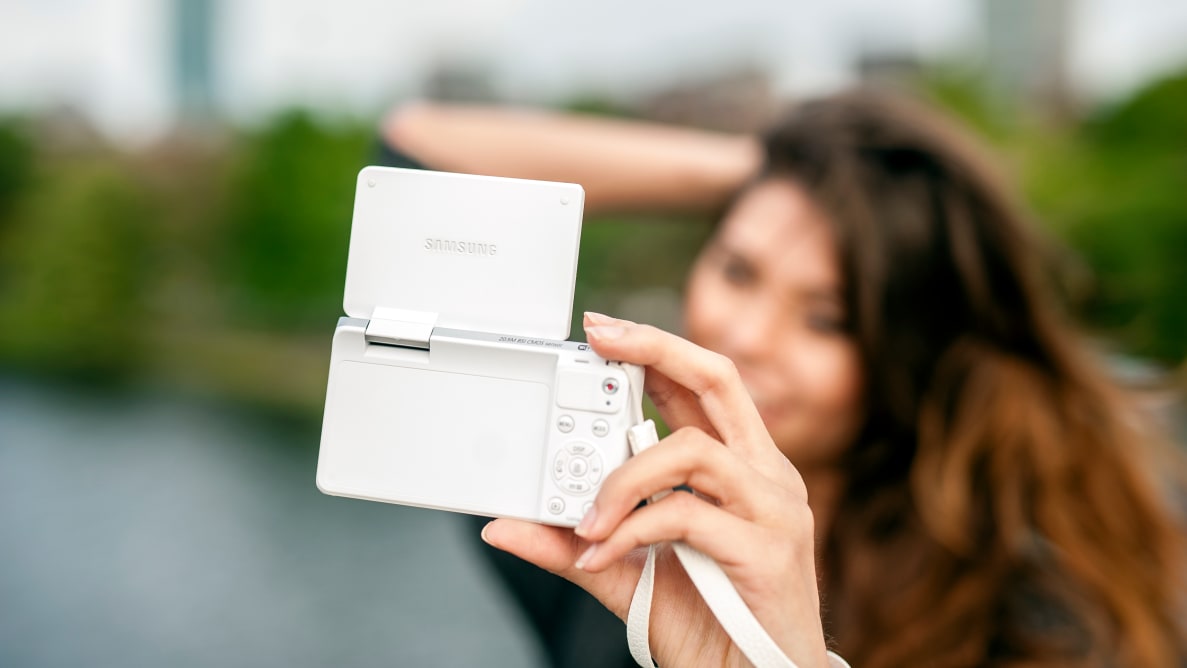The last thing we imagined Samsung doing was creating a second, even smaller system. Well, Samsung did exactly that when it announced the NX Mini (MSRP $449.00).
This is the first camera in a brand new lens system based around a 1-inch sensor, the same size as Nikon's 1-series and noteworthy point-and-shoots like the Sony RX100 and the Panasonic Lumix FZ1000. With three tiny lenses in tow, this miniature Samsung combines adorable proportions with retro panache. When mated to its itty-bitty 9mm lens, this camera gives users a big field of view perfect for the selfie generation.
Design & Handling
Cute as a button
When we first laid eyes on the NX Mini, we were struck with how neat it looked. Instead of the plasticky, modern design of the NX2000, the NX Mini closely apes the stylish NX300's kinda-sorta retro style. We think it looks fantastic, and even though our review unit was the white variant, the unique brown and mint green colors are standouts in a sea of monochrome cameras.
The 9mm lens included with the least expensive version of the NX Mini is an adorable little lens. Potential buyers should know, though, that no matter how hard you look through the box, you won't find a lens cap. Instead, the lens was designed to resist scratches all by itself. We felt more than unnerved putting a mirrorless camera into our bags without a lens cap. As far as we can tell, the little 9mm wasn't any worse for wear after carrying it for a few days without protection.
{{ photo_gallery "tour" }}
The camera's thin body is impressive to look at, but it's understandably compromised ergonomically. While it's fine for quick snaps, it's awfully difficult to hold on to for more than a few minutes at a time. The buttons on the back of the camera are understandably small, but nevertheless difficult to press sometimes. We also found fault with the shape and size of both the power and Direct Link buttons. Both controls are located next to each other, and are the same shape and diameter. On more than one occasion, we accidentally shut off the camera when trying to access WiFi, and vice versa.
We were a little annoyed that you can only use MicroSD cards in the Mini. We love MicroSD sometimes, but it's awfully fiddly to pop into and out of a camera. Like other Samsung Smart Cameras, the littlest NX charges via Micro USB. That means that many people won't need to pack a separate charger, since most smartphone chargers will do the same job. You win some, you lose some.
Unfortunately, even though the camera feels pretty well built, the rear LCD is a real weak point. We found the screen very difficult to see in bright sunlight. Furthermore, the plastic screen cover collects and hangs onto fingerprints like nobody's business, making it even harder to use. A simple hinge mechanism lets you shoot from hip level, and of course it pivots 180 degrees to face frontwards for the all-important selfies. As a selfie camera, the NX Mini does a great job, turning on if you flip the screen out, making it ready for action whenever.
Features
A lot of features in a little camera
One thing the NX Mini doesn't suffer from is a lack of features. Samsung threw in many of its best tricks. Since it shares its DNA with other NX offerings, Samsung has done an admirable job at bolstering this little guy's spec sheet with some really premium additions.
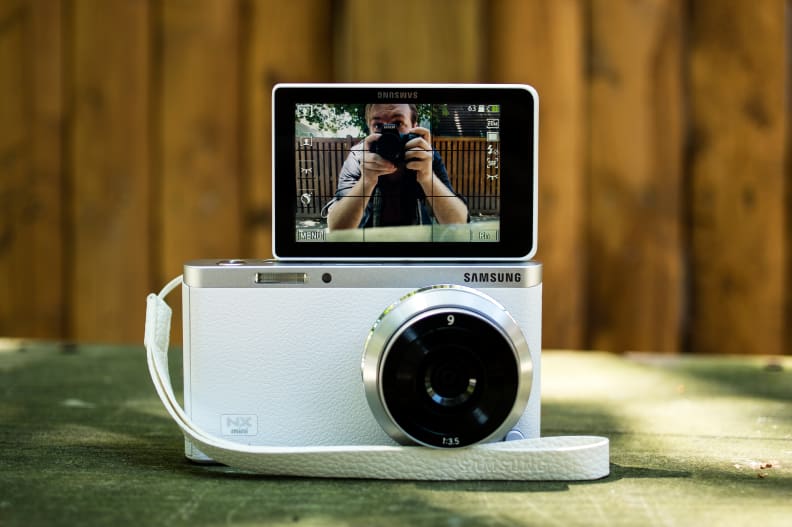
The screen flips all the way forward allowing for all the selfies to be had.
Of course, WiFi is built-in and it works pretty well. The only recommendation we have is that if you're sharing a lot of photos to the internet as you take them, you should switch into a lower resolution mode. The NX Mini's 20-megapixel sensor has plenty of resolution, which also makes files a little big for quick transfer to your phone. We found that the 10-megapixel mode was more than good enough for web posting. Otherwise, that little status bar will take a lot longer to move each photo to your smartphone, and you can't shoot again until it's done.
One selling point that Samsung continues to underscore is the inclusion of Adobe Lightroom. Normally, you'd have to shell out over a hundred bucks to get this, but it comes for free with every NX Mini. Since the large-sensored Mini can shoot RAW, this is an excellent way to get your feet wet when it comes to developing your own digital pictures.
All things considered, the NX Mini's video features are underwhelming. Even though Samsung's other system cameras offer plenty to video shooters, this tiny addition to the lineup didn't score nearly as high as other 1-inch cameras like Sony's RX100 cameras. Overall, if you need a compact camera to shoot decent video, an RX is a way better choice.
{{ photo_gallery "design" }}
The only crowd that this li'l guy won't please are the demanding enthusiasts. The simplified controls and very limited system both contribute to this feeling more like a point-and-shoot than a full interchangeable lens camera. The entire experience isn't nearly as deep or a full of potential as the Panasonic Lumix GM1. That said, the GM1 can't do selfies like the NX Mini can and for people looking at this camera, that's a big deal.
Performance
This half-pint ain't half bad.
We came away mostly impressed with the NX Mini's still photography skills. For such a small camera, it managed to take some very impressive shots. It's certainly a massive upgrade if you've just been using your smartphone for most of your photography. It basically kept up with bigger, heavier cameras like Canon's EOS Rebel T5 and the Nikon D3300 in many important regards. The down side is that we found the NX to be a little temperamental in the labs, giving us inconsistent exposure and noise figures in some cases. Even though it was a tad mercurial, we still learned to appreciate it in the real world.
{{ photo_gallery "sample-photo" }}
The biggest disappointment came in the form of the NX Mini's video performance. Video was of middling quality, with mediocre low light performance. Even though full 1080p HD is an option, you'll be limited to 30 fps. We were really hoping for a bit more from Samsung, since its other NX cameras were perfectly respectable performers in this regard. The NX Mini failed to keep up with the Sony RX100 II, which remains a much better choice for those who want great HD video from a small camera.
Moreover, continuous shooting was only yielded results of 10 shots at around 6 fps. After that, the buffer filled and your frame rate will slow greatly. Compare that to many of the Nikon 1 cameras, which have unbelievably fast burst shooting capabilities. If you want the fastest burst shooting you can get in a tiny camera, start looking at Nikon's system.
Check out our Science Page for more information on how the NX Mini performed.
Conclusion
Perfect for new-school social photographers
While we would hesitate to recommend this camera to hardcore photography buffs, we had a blast shooting with it. Perhaps it's because we prefer a nice prime lens to a lackluster zoom, but the combination of the NX Mini with the 9mm f/3.5 pancake made it into a great package that we didn't mind carrying all day.
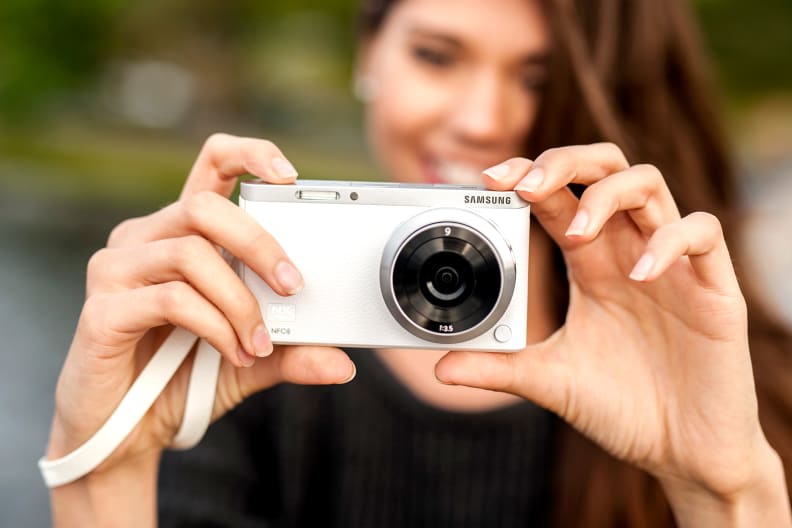
If you're in the market for a compact camera with interchangeable lenses, put the NX Mini on your shopping list.
No matter how you cut it, this camera gives the Nikon 1 a run for its money. The NX Mini is significantly trimmer than Nikon's older and similarly-priced 1 J3, which also needs a cludgy external module if you want to use WiFi. It's a clear shot across the bow of the slow-to-evolve Nikon 1 series, which started strong only to languish for far too long. A Sony RX100 would be a better comparison, if only those cameras weren't fixed-lens point-and-shoots.
Like we mentioned previously, the enthusiast choice is hands-down the Panasonic Lumix GM1, a fantastic camera in an impossibly small body. It's about $250 more, but it has a bigger sensor and you also get a wide array of lens choices thanks to its Micro Four Thirds mount. But, the NX is quite a bit cheaper and, you get Lightroom thrown in for free. Most of the arguments we can make go along these lines. If you have around $400 to spend on a small interchangeable lens camera, the NX Mini is sure to please.
We will quickly admit that the NX Mini's lens catalog is sparse, but we feel that its big sensor and nice feature set mean that you don't necessarily have to wait for new lenses for this to be an attractive purchase. It's too bad that other miniature mirrorless cameras couldn't reach this price/feature sweet spot sooner (ahem, we're looking at you, Pentax Q). Out of the gate, it hits all the right notes, blending features and design with good performance at a price that won't make you cringe.
By the Numbers
The Samsung NX Mini came into our labs as something of an enigma. Though we’re very familiar with 1-inch CMOS image sensors from our time with Sony’s line or RX100 cameras and Nikon’s 1 system, this is Samsung’s first crack at the format.
As a result this was one of the rare times where we simply didn’t know what to expect. Samsung’s sensor production capabilities rival Sony’s and we’ve been very impressed with cameras like the NX300 and NX30. Would Samsung’s new compact system camera line debut with a bang? Or would Samsung’s 1-incher once again be a product of compromise? The results tell the story of a camera that can easily hang with the best 1-inch sensors on the market in ideal conditions, but inconsistent metering and some heavy-handed processing can be frustrating.
Color Accuracy & White Balance
The first test that we always run to get an idea of how a camera performs is color accuracy. Right away, the NX Mini gave us some fits. The best result was truly great—better than even many high-end DSLRs—but the results we got from shots that immediately followed were average, at best. Ultimately we got better great results than poor ones, but the inconsistency is worrisome.
We got our best results with the “Portrait” color mode, which yielded a ∆C00 (saturation corrected) error of just 2.08. Since anything less than 2.2 is excellent, this is a great score. Saturation came in at around 107.5%, which was pleasing without being overbearing.
In the other modes (such as “Standard” and “Landscape” modes) the NX Mini does well, but color errors hover around 2.4-2.7 depending on what you’re shooting. The “Vivid” mode was the worst, as you’d expect, prizing punchy photos over clinical accuracy.
The NX Mini had similar problems in our controlled white balance test. In that test we shoot with both automatic and custom white balance modes under daylight, incandescent, and tungsten lighting conditions. Under all three settings the NX Mini did well, occasionally excelling and frequently struggling, often in back-to-back shots. The main culprit is exposure, which would move up and down by as much as a full stop without warning.
For auto white balance the NX Mini was among the best we’ve ever tested under incandescent lighting, with an error of under 120 kelvins. Most cameras have errors in excess of 2,000 kelvins, so this is truly excellent. It was off by around 150 and 200 kelvins under fluorescent and daylight conditions, respectively, but that’s typical. None of the custom white balance results had major errors, so you can use them whenever you need a more accurate result.
Resolution
We tested the new NX Mini with Samsung's newest "kit" lens, the 9mm f/3.5. This lens only works with the NX Mini, latching onto the camera via the new lens mount. In our tests it did fairly well, though Samsung clearly helped it out with a heaping dose of oversharpening to bring out fine details and lend contrast to the edge of subjects.
In our tests the NX Mini routinely managed to resolve an impressive 2,000 line widths per picture height at a contrast level of MTF50 in the center of the frame. That performance falls off to just over 1,600 LW/PH at MTF50 in the corners, as well, making for a pretty sharp image in general... at least when shooting JPEG.
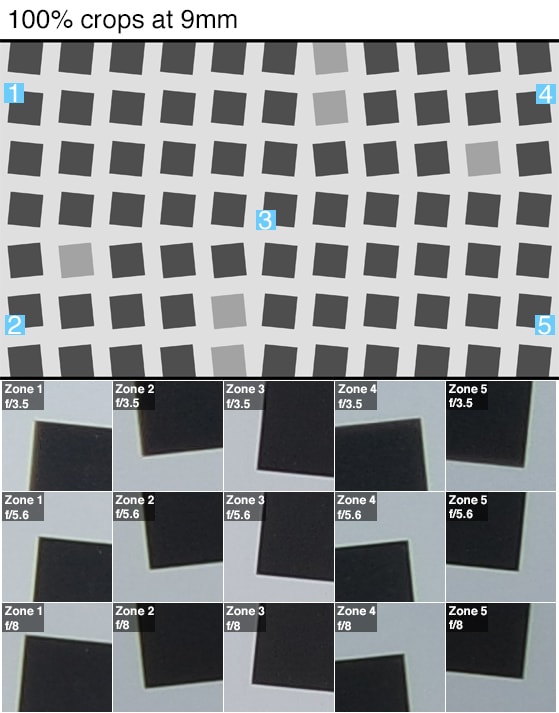
RAW shots will be significantly softer in the corners, as Samsung helps things along by applying as much as 20% oversharpening to its images. The RAWs don't appear to be as cooked, but until we have official support from Adobe's Lightroom developer we can't be sure. Either way, both our lab tests and our real world performance show a camera that is sharp enough for prints and the web, though a little bit of post-processing doesn't hurt.
Noise Reduction
The NX Mini’s RAW noise characteristics were very odd in our tests. In both JPEG and RAW there seems to be an odd change in how shots are handled at ISO 800 and above. We’re not entirely sure what the problem here is. Lightroom (which is included with the NX Mini) opened the RAW files just fine, even though the NX Mini is not listed as officially supported, so it’s possible our issues arose from that.
In JPEG things are much clearer. The NX Mini lets you shoot with an ISO range of 160-12,800 and there are four levels of noise reduction: low, medium, high, and off. With NR set to low noise starts at around 0.68% and rises steadily, hitting 1% at ISO 800 and 1600 and 1.84% at ISO 6400. It tops out at 2.47% at ISO 12,800. Though this is supposedly “off” there’s clearly some measure of reduction being applied anyway, but you can safely shoot through ISO 3200 before image quality takes a major dive.
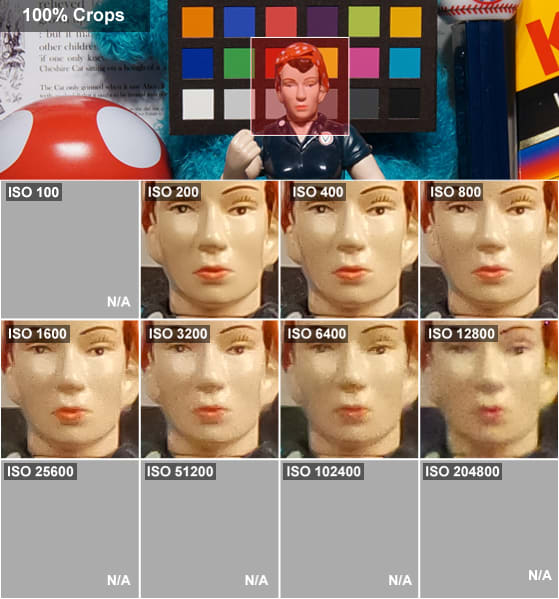
If you tune NR to low things just get funky right away. Noise only tops 1% at ISO 12,800 with NR set to “low,” where it hits 1.6%. Since 2% is our usual threshold for print-quality images, this result sounds great, but it’s merely Samsung being over-aggressive with its noise reduction process.
Medium and High NR are not much more aggressive, but they do weird things. They both start at just 0.58% noise, hitting 1% on the nose at ISO 800 before falling slightly and rising back up to around 1.5% at max ISO. They aren’t much different from NR Low, so we’re not sure what Samsung was going for here. Our advice is just to shoot with NR off or in RAW once a better profile has been developed.
Dynamic Range
As with our noise test, the issue we’re having with dynamic range is the NX Mini’s odd behavior when developed with Lightroom 5.4. The files go through just fine, but there appears to be a severe crushing of the green channel in shadow areas that makes dynamic range appear much better than it is.
At base ISO things seem to behave much more normally and this is where the NX Mini, predictably, sees its best results. There we managed to see dynamic range on par with most entry-level DSLRs—even APS-C cameras. By the industry standard measurement of dynamic range (the number of stops where the signal to noise ratio exceeds 1:1) the NX Mini had right around 12.5 stops of dynamic range. We score based on a higher standard (cutting off measurement where SNR is above 10:1) and there the NX Mini manages over 7 stops at ISO 160.
What does this mean? Similar to our other results the NX Mini is a camera that, at its very best, punches far above its weight. But a nagging inconsistency seems to haunt it in nearly every one of our tests, holding it back from a more enthusiastic recommendation.
Shot-to-Shot speed
One area where the NX Mini is unquestionably worse than the Nikon 1 series is in continuous shooting. Where Nikon’s 1-series cameras can all manage 40+ frames per second at full resolution the NX Mini topped out at just 6 frames per second.
It’s not just speed that’s the issue, though. Even shooting just 6 fps the NX Mini could only record 10 JPEGs at the “Superfine” quality setting before slowing down to a trickle. If you shoot RAW+JPEG thing get even worse, as the camera hits the same speed but only for four shots. If you limit your shooting to just RAW then you can get five frames, but it’s nowhere near what other cameras in this class can do.
Video Performance
Video performance was also a mix of both positives and negatives with the NX Mini. It handled our test motion rig well, but fine detail and low light proved to be trouble spots for Samsung’s latest camera. Though Samsung has generally impressed us with the video quality of its NX line of interchangeable lens cameras, this is a big area where the next iteration of the NX Mini can improve greatly.
In our video motion test the NX Mini did about as well as any other entry-level interchangeable lens camera. Motion was fairly crisp with some hints of trailing and ghosting. There was also some clear rolling shutter and artifacting evident in our test video, even without moving the camera.
Once we moved to the video sharpness test, however, the cracks in the NX Mini’s video veneer began to show. In bright light the camera could only resolve around 450 line pairs / picture height horizontally and 500 LPPH vertically, while in low light that dropped to just 350 LPPH horizontal and 375 LPPH vertically. The main issue is the small sensor, which also struggled in our low light sensitivity test. There it needed 11 lux of light to produce a usably bright image. That’s not the worst result we’ve seen from a small-sensor camera, but it’s noticeably worse than what we usually get from entry-level APS-C cameras.
Overall the video performance is like most of our tests: inconsistent, at best.
Meet the tester
Brendan is originally from California. Prior to writing for Reviewed.com, he graduated from UC Santa Cruz and did IT support and wrote for a technology blog in the mythical Silicon Valley. Brendan enjoys history, Marx Brothers films, Vietnamese food, cars, and laughing loudly.
Checking our work.
Our team is here for one purpose: to help you buy the best stuff and love what you own. Our writers, editors, and lab technicians obsess over the products we cover to make sure you're confident and satisfied. Have a different opinion about something we recommend? Email us and we'll compare notes.
Shoot us an email
